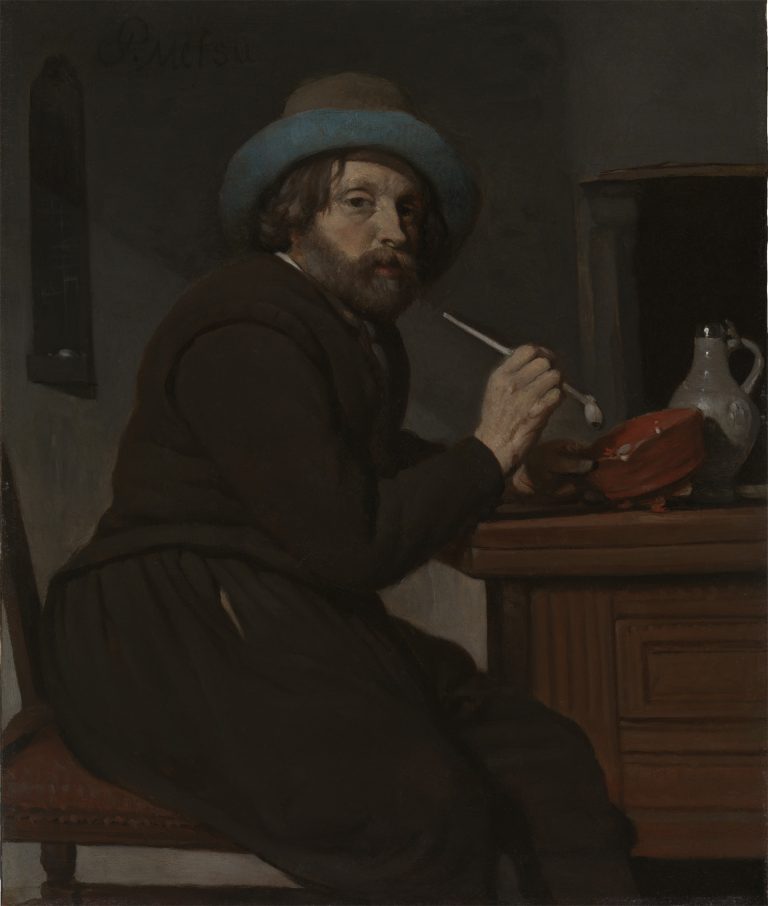Gabriel Metsu used almost exclusively canvas supports during his early years in Leiden, but preferred small oak panels during his mature career in Amsterdam. Only once did he choose a copper support, in 1654–57, when he painted Smoker Seated at a Table. The smooth surface of this relatively soft but durable metal allowed him to employ a more meticulous technique than in his earlier paintings. Indeed, Smoker Seated at a Table marks a significant step in Metsu’s artistic evolution during his first years in Amsterdam, at which time he gradually abandoned the fluid brushwork characteristic of Jan Baptist Weenix (1621–60/61) in favor of the more refined and softer technique of Gerrit Dou (1613–75). Although Metsu’s technique here does not match the delicacy of Dou’s manner of painting or that of his own highly finished paintings from later in his career, Smoker Seated at a Table reflects his deliberate move towards “fine” painting in the Leiden manner.1 Metsu painted in this way either to meet an existing demand for “fine” paintings in Amsterdam or to create a market for such works on his own accord.2
The painting represents a middle-aged bearded man who sits at a table enjoying a smoke. He holds his pipe upside down to light the tobacco by dipping it into the burning coals in an earthenware brazier. The small black board with an arched top in the left background indicates that the setting is a tavern. Innkeepers and serving staff used such slate panels to tally their customers’ drinks, as can be seen in the background of Metsu’s A Woman Offering a Glass of Wine to a Man (fig 1). The smoker who, to judge from his woolen suit and round hat, is a farmer, has already been served his beer in a white tankard that rests on his table.3 He looks out at the viewer with a brazen yet sympathetic gaze, not unlike that of the bearded figure in Public Notary (GM-101), which Metsu had completed a few years earlier.
The present painting belongs to a long tradition of Dutch and Flemish images of men drinking and smoking in a tavern—paintings commonly seen in collectors’ homes, the shops of art dealers, and the workshops of other painters. Metsu depicted this subject no less than five times, the most renowned of which is An Old Man Holding a Pipe and a Jug from the mid-1650s (fig 2).4 Metsu’s depictions of older men and women engaged in their individual activities owes much to Dou, who had featured elderly people in many of his early paintings.5 Unlike other of Metsu’s works, however, neither the composition nor the male figure in this painting has a precedent in Dou’s works. In fact, the man’s facial features do not even reappear in other paintings by Metsu, which raises the possibility that Smoker Seated at a Table is a genre-like portrait.
The coloration of Smoker Seated at a Table relates closely to Metsu’s other early Amsterdam paintings, among them A Woman with a Jug and a Man with a Pipe (fig 3). During this period of his career Metsu characteristically set off flesh tones, whites and areas of bright color, often bluish-greens or orange-reds, against a gray background. In A Woman with a Jug and a Man with a Pipe, the woman’s apron is the single coloristic focal point, whereas in Smoker Seated at a Table it is the rim of the man’s hat. Metsu’s sensitivity toward color is evident in the way he has here modulated the gray tonality of the painting with the browns of the earthenware brazier, the wooden table, and the upholstery of the chair.
Smoker Seated at a Table includes a number of objects that appear in some of Metsu’s other paintings. The table, for example, is seen in several later works, including A Man Offering a Glass of Wine to a Woman, which Metsu completed in 1667, the last year of his life.6 It is likely that the artist owned this piece of furniture. The same is probably true for the earthenware brazier and the white jug. Although the same chimney does not feature in other paintings, it does resemble those in other of Metsu’s early Amsterdam works, including A Woman with a Jug and a Man with a Pipe.
Although it appears differently today, Metsu originally signed A Smoker Seated at a Table in the top left corner with an unusual signature: G.Metsùe.7 The artist generally inscribed his name GMetsu or Gmetsu (G and m in ligature), but he added an E to his name in eleven extant works. Most of these date from the last few years of his life.8 What may have prompted him to vary his signature is unknown. Some of the artist’s distant family members are also known to have signed their name Metsue.9 It should be noted that consistency in spelling was not as important in the seventeenth century as it is today, and people often wrote their names in different ways.
